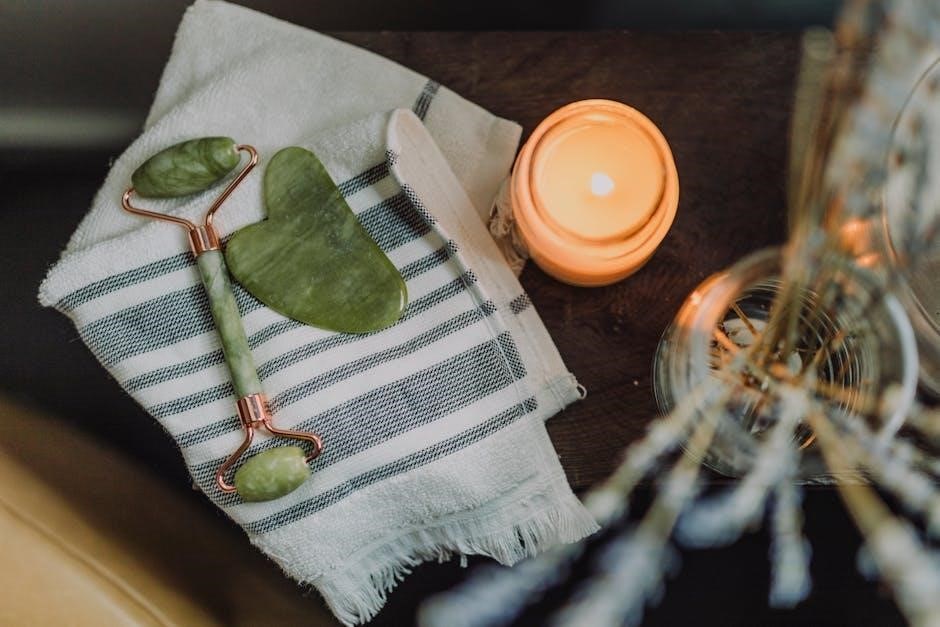
self bondage guide
Self-bondage is a form of self-restraint involving ropes, cuffs, or locks, often linked to BDSM practices. It carries significant risks, requiring caution, preparation, and education.
Definition and Overview
Self-bondage involves restraining oneself using ropes, cuffs, or locks, often for personal exploration or BDSM-related activities. It requires careful planning and knowledge of safety measures to minimize risks. While it can be an exciting way to explore control and sensation, self-bondage demands responsibility and awareness of potential dangers, especially when practiced alone. This practice is not without risks, making education and caution essential for a safe experience.
Risks and Safety Considerations
Self-bondage poses significant risks, including asphyxiation, nerve damage, and circulation issues. Improper techniques or equipment can lead to serious harm, even death. Mental health is also a concern, as the practice can trigger emotional distress. Experts strongly advise against self-suspension and stress the importance of in-person instruction. Never attempt self-bondage alone without a reliable emergency release plan. Understanding these risks is crucial to ensure a safe and controlled experience. Proper precautions and knowledge are essential to mitigate potential dangers.
Essential Tools and Gear for Self-Bondage
Key tools include durable ropes, padded cuffs, and secure locks. DIY solutions like magnet locks and ice locks enhance scenarios, requiring proper gear for safe experiences.
Types of Restraints: Cuffs, Ropes, and Locks
Cuffs offer quick and adjustable restraint, while ropes provide versatility for intricate binds. Locks ensure security, with options like magnet or ice locks for timed releases. Each tool serves unique purposes, from immobilization to sensory play, requiring careful selection based on experience level and scenario. Proper use of these restraints is essential for both safety and desired outcomes in self-bondage practices.
Homemade and DIY Solutions
For those exploring self-bondage, homemade solutions can be creative and cost-effective. Everyday items like scarves, stockings, or belts can serve as makeshift restraints. DIY enthusiasts often craft their own cuffs using fabric or plastic, while others repurpose household items for unique binds. Simple knots and harnesses can also be mastered with practice, allowing for personalized restraint systems. Testing materials for durability and comfort is crucial to ensure safety and reliability in homemade setups.

Safety First: Precautions and Best Practices
Prioritize safety in self-bondage by planning thoroughly, using reliable gear, and establishing emergency release methods. Always practice self-care and stay aware of physical and mental limits.
Planning and Preparation
Proper planning is crucial for safe self-bondage. Assess your experience level and choose techniques that align with your skills. Select appropriate gear and ensure it is in good condition. Set a clear time limit for your session and plan for emergencies, such as having a release method or tool nearby. Mentally prepare by understanding your limits and staying calm. Always prioritize your well-being and consult reliable resources or guides to avoid risks. Preparation is key to a safe and enjoyable experience.
Physical and Mental Considerations
Physical and mental well-being are vital in self-bondage. Avoid restraints that restrict circulation or cause nerve pressure, as this can lead to injury. Consider pre-existing health conditions, such as joint issues or diabetes, which may complicate bondage. Mentally, ensure you’re calm and not under stress, as anxiety can heighten risks. Be aware of your emotional limits and how confinement might affect you. Always prioritize your safety and well-being, starting with simple techniques and gradually exploring more complex methods.
Emergency Release Methods
Emergency release methods are essential for self-bondage safety. Always have a reliable way to free yourself, such as a magnet lock, ice lock, or hidden key. Ensure these tools are easily accessible and fail-safe. Plan for emergencies, like having a backup release mechanism, to prevent prolonged entrapment. Regularly test your release methods to ensure they work effectively. Never rely solely on one technique—always have a contingency plan ready. Safety should never be compromised.

Basic Techniques for Tying Yourself Up
Start with simple knots and wrist/ankle restraints. Gradually incorporate chest harnesses and limb ties. Always plan escape routes and release mechanisms for safety.
Simple Knots and Harnesses
Begin with foundational knots like the square and clove hitch, which are easy to tie and secure. Harnesses can be created by looping rope around wrists or chest. Always ensure knots are snug but not overly tight to avoid circulation issues. Practice on non-vital areas first to build confidence. Incorporate quick-release methods to ensure safety. Start slow and gradually increase complexity as skills improve. Safety and comfort should always be prioritized.
Step-by-Step Instructions for Common Bonds
Begin with a basic chest harness by looping rope around your torso and shoulders. Secure the rope with a square knot at the back, ensuring it’s snug but not overly tight. For wrist bonds, tie each wrist separately using a clove hitch or square knot, leaving enough slack to avoid cutting circulation. Integrate a quick-release mechanism, such as a carabiner or slipknot, for easy escape. Practice slowly and methodically, checking comfort and safety at each step. Patience is key to mastering these techniques.

Advanced Self-Bondage Techniques
Explore intricate positions and scenarios, incorporating furniture or environmental restraints for heightened complexity. Creative use of space and tools can enhance the experience while maintaining safety.
Creative Positions and Scenarios
Creative positions in self-bondage can enhance the experience by adding variety and intensity. Consider unique setups like spreading your limbs across a bed or chair, incorporating sensory deprivation, or using furniture to create immobilizing poses. Exploring scenarios that challenge your physical and mental limits can deepen the sensation of restraint. Always plan meticulously, ensuring a safe and controlled environment. Use creative tools or props to diversify your binds, and consider time-based challenges to test endurance. Remember, safety and release mechanisms are paramount in any advanced scenario.
Using Furniture and Environmental Restraints
Furniture and environmental restraints offer creative ways to enhance self-bondage. Utilize bed posts, chairs, or door handles to immobilize yourself. For example, tie your wrists to bedposts or loop rope around a sturdy chair. Incorporating household items like belts or scarves can add variety. Ensure the furniture is stable to avoid accidents. Use quick-release knots or locks for emergencies. Environmental restraints not only add intensity but also allow for unique and versatile bondage scenarios, making your experience more dynamic and engaging while maintaining safety.
Aftercare and Recovery
Aftercare is crucial post-self-bondage, addressing both physical and emotional needs. Check for injuries, rehydrate, and engage in relaxation techniques to ensure a safe recovery and well-being.
Physical and Emotional Aftercare
Aftercare is essential to ensure physical and emotional well-being post-self-bondage. Check for injuries, rehydrate, and rest to prevent fatigue. Emotionally, provide comfort, reassurance, and open communication to address any feelings or stress. Engage in calming activities like meditation or gentle stretching to relax. Proper aftercare fosters a safe and nurturing environment, promoting overall recovery and readiness for future experiences. Prioritize self-compassion and patience, allowing time to process the experience fully.
Rehydration and Relaxation Techniques
Rehydration is crucial after self-bondage to replenish lost fluids. Drink water gradually to avoid overwhelming your system. Herbal teas or electrolyte-rich beverages can also help. For relaxation, practice deep breathing exercises to calm your mind and body. Gentle stretches or progressive muscle relaxation can ease physical tension. Consider mindfulness or meditation to center yourself emotionally. These techniques promote recovery, ensuring you feel refreshed and balanced after your experience.

Legal and Ethical Considerations
Understanding consent and responsibility is vital in self-bondage. Ensure activities are legal in your region and align with ethical practices, respecting personal boundaries and societal norms.
Understanding Consent and Responsibility
Consent is the cornerstone of self-bondage, ensuring all actions are voluntary and understood. Participants must acknowledge risks and take full responsibility for their well-being. Clear communication and boundaries are essential to ensure safety and ethical practices. Self-bondage requires mindfulness of legal implications, as laws vary by region. Always prioritize personal autonomy and respect for oneself and others involved in the activity. This ensures a safe and consensual experience for all parties.
Local Laws and Regulations
Local laws and regulations regarding self-bondage vary significantly by region. Some jurisdictions may restrict certain BDSM practices or equipment, while others may not. It is crucial to understand the legal framework in your area to avoid potential legal consequences. Research local statutes and consult legal resources to ensure compliance. Restrictions on paraphernalia like restraints or gags may apply, so awareness of these laws is essential for safe and lawful practice. Always stay informed to protect yourself legally.
Thank you for exploring this guide to self-bondage. Remember, safety and consent are paramount. Continue learning, stay curious, and always prioritize your well-being. Happy exploring!
Final Thoughts and Encouragement
Self-bondage is a journey that requires patience, education, and self-awareness. Always prioritize safety and consent, whether exploring alone or with a partner. Start with simple techniques, gradually building confidence and skill. Remember, the goal is enjoyment and personal growth. Seek community resources and expert guidance to enhance your experience. Stay curious, embrace creativity, and never hesitate to seek help when needed. Happy tying!
Recommended Resources for Further Learning
For deeper exploration, consider The Ultimate Guide to Kink and How to be Knotty for expert techniques. Online platforms like FetLife offer communities and forums. Videos and tutorials on self-bondage safety are available on YouTube. Books on shibari and BDSM provide historical context and advanced methods. Websites specializing in BDSM education, such as Kink Academy, offer courses and workshops. Always vet sources for credibility to ensure safe and informed practice;